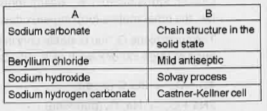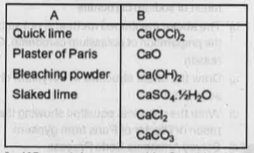Complete Solutions to QUESTION BANK of chapter THE S-BLOCK ELEMENTS of Class 11 book with complete answers and questions
| Class 11 | CHEMISTRY |
| Chapter | THE S-BLOCK ELEMENTS |
| A N EXCEL PUBLICATION | QUESTION BANK |
| Number Of Questions | 71 |
| Academic Year | 2023-24 |
The group 1 metals of the periodic table of elements are collectively called alkali metals. Alkali metals are never found free in nature. Give reason.
View SolutionFind the oxidation state of sodium in `Na_2O_2`
View SolutionExplain why Na is less reactive than K?
View SolutionCompare alkali metals and alkaline earth metals with repect to ionisation enthalpy, basicity of oxides and solubility of hydroxides.
View SolutionExplain why alkali and alkaline earth metals cannot be obtained by chemical reduction methods?
View SolutionWhy are potassium and caesium, rather than lithium used in photoelectric cells?
View SolutionWhen an alkali metal dissolves in liquid ammonia the solution can acquire different colours. Explain the reasons for this type of colour change
View SolutionBeryllium and magnesium do not give colour to flame whereas other alkaline earth metals do so, why?
View SolutionPotassium carbonate cannot be prepared by Solvay process. Why?
View Solution`Li_2CO_3` decomposes at a lower temperature whereas `Na_2CO_3` at higher temperature.why?
View SolutionStarting with NaCl how would you proceed to prepare
Na metal
View SolutionStarting with NaCl how would you proceed to prepare
Na metal
View SolutionStarting with NaCl how would you proceed to prepare
`Na_2O_2`
View SolutionStarting with NaCl how would you proceed to prepare
`Na_2CO_3`?
View SolutionA piece of magnesium is burned in air. What do you observe ?
View SolutionWhat happenes when
quick lime is heated with silica
View SolutionWhat happens when slaked lime is treated with dry chlorine?
View SolutionWhat happenes when
calcium nitrate is heated?
View SolutionDraw the structure of
`Becl_2`(vapour)
View SolutionAlkali metals and alkaline earth metals belong to the s-block of the periodic table. Draw the chain structure of beryllium chloride in solid state.
View SolutionThe hydroxides and carbonates of Na and K are solube in the water while those of Mg and Ca are spairingly soluble .Explain.
View SolutionWhy are lithium salts commonly hydrated and those of other alkail metal ions usually anhydrous?
View SolutionWhy is LiF almost insoluble in the water while LiCl is soluble not only in water but also in acetone?
View SolutionWhat happens when
Na is dropped in water
View SolutionWhat happens when
Na is heated in free supply of air
View SolutionWhat happens when
sodium peroxide dissolves in water?
View SolutionComment on the following observation
The mobility of alkali metal ions in aqueous solution Is `Li^+ lt Na^+ lt K^+ lt Rb^+`
View SolutionComment on the following observations
Lithium is the only alkali metal which forms nitride directly.
View SolutionState as to why
a solution of `Na_2CO_3` is alkaline
View Solutionwhy alkali metals are prepared by electrolysis of their fused halides
View SolutionWhich of the alkali metals is having least melting point?
View SolutionWhich of the following gives hydrated salts.Li, Na,K,or Cs?
View Solutionwhich of the most thermally stable carbonate among `MgCO_3`,`CaCO_3`,SrCO3`and `BaCO3`?
View SolutionThe group 1 metals of the periodic table of elements are collectively called alkali metals.Write the general electronic configuration of alkali metals
View SolutionThe group 1 metals of the periodic table of elements are collectively called alkali metals. Identify the alkali metal exhibiting anomalous properties. Explain.
View SolutionThe group 1 metals of the periodic table of elements are collectively called alkali metals. Alkali metals are normally kept in kerosene. Why?
View SolutionThe group 1 metals of the periodic table of elements are collectively called alkali metals. Alkali metals are never found free in nature. Give reason.
View SolutionSay whether the following are true or false:
a) On moving across a period ionization enthalpy decreases.
b) Mg is bigger than Cl.
c) Ionization enthalpy of Li is less than that of K.
View SolutionThe group 1 metals of the periodic table of elements are collectively called alkali metals. Alkali metals are never found free in nature. Give reason.
View SolutionState whether the following sentences are true or false:
Baking soda is chemically sodium hydrogen carbonate
View SolutionState whether the following sentences are true or false:
Portland cement is basically silicates and aluminates of calcium
View SolutionThe chemical formula of Plaster of Paris is
View SolutionBeryllium shows a diagonal relationship with aluminium. Mention any two similarities between beryllium and aluminium
View SolutionThe metal present in the chlorophyll of plants is _____.
View SolutionFill in the blanks: (a) Molecular formula of Plaster of Paris ________. (b) Beryllium shows diagonal relationship with ________. (c) The metal present in chlorophyll is _____.(d) Solvay process is associated with the preparation of ________.
View SolutionMonovalent `Na^+`, `K^+` ions and divalent `Ca^(2+)` , `Mg^(2+)` ions are found in large proportions in biological fluids. In which part of our body are sodium and potassium ions prominently located?
View SolutionMonovalent `Na^+`, `K^+` ions and divalent `Ca^(2+)` , `Mg^(2+)` ions are found in large proportions in biological fluids. What are the major roles of these Na and K ions in our body ?
View SolutionMonovalent `Na^+`, `K^+` ions and divalent `Ca^(2+)` , `Mg^(2+)` ions are found in large proportions in biological fluids. For making which parts of our body, calcium is mainly used?
View SolutionMonovalent `Na^+`, `K^+` ions and divalent `Ca^(2+)` , `Mg^(2+)` ions are found in large proportions in biological fluids. Give the name of the metal present in Chloro phyll.
View SolutionBeryllium shows a diagonal relationship with aluminium. Mention any two similarities between beryllium and aluminium
View SolutionMatch the following:

View SolutionLithium and Magnesium belong to 1st and 2nd groups in the periodic table. They resemble each other in many respects.(i) Name such relationship.(ii) Give any one similarity between Li and Mg.
View SolutionLithium and Magnesium belong to 1st and 2nd groups in the periodic table. They resemble each other in many respects.(i) Name such relationship.(ii) Give any one similarity between Li and Mg.
View SolutionA compound of calcium is used for immobilising the fractured bones of body. Write down the common name and molecular formula of the compound.
View Solutioncompound of calcium is used in hospitals for setting fracture of bones.(i) Write the name and formula of the above compound. (ii) What is dead burnt plaster?
View SolutionAlkali metals and alkaline earth metals belong to the s-block of the periodic table. Name the process used for the industrial preparation of sodium carbonate.
View SolutionAlkali metals and alkaline earth metals belong to the s-block of the periodic table. Name the process used for the industrial preparation of sodium carbonate.
View SolutionAlkali metals and alkaline earth metals belong to the s-block of the periodic table. Draw the chain structure of beryllium chloride in solid state.
View SolutionAlkali metals and alkaline earth metals belong to the s-block of the periodic table. Write the chemical equation showing the preparation of Plaster of Paris from gypsum.
View SolutionFill in the blanks
The suspension of a magnesium compound in water is used as an antacid. The compound is _____
View SolutionFill in the blanks : (i) The suspension of a magnesium compound in water is used as an antacid. The compound is _______. (ii) A mixture of calcium oxide (Quick lime) and Soda (NaOH) is called _______.
View SolutionOn passing `CO_2` through lime water, milkiness appears. On further passing `CO_2`, milkiness disappears. What is the Chemistry behind it?
View SolutionGive reasons
`KO_2` is paramagentic
View SolutionAlkali metals dissolve in liquid ammonia to give blue coloured solutions. Why?
View SolutionMatch the following:

View SolutionThe metal present in the chlorophyll of plants is _____.
View SolutionGive any two uses of caustic soda
View SolutionWhen sodium metal dissolves in liquid ammonia, it gives a deep blue coloured solution. Explain the reason.
View SolutionAlkali metals dissolve in liquid ammonia to give blue coloured solutions. Why?
View SolutionPlaster of Paris is an important compound of Calcium. (i) Give the chemical formula of plaster of Paris.
View SolutionPlaster of Paris is an important compound of Calcium
Identify the property of plaster of Paris which helps in plastering of broken bones.
View Solution
QUESTION BANK questions and complete solutions for chapter THE S-BLOCK ELEMENTS of A N EXCEL PUBLICATION of Class 11